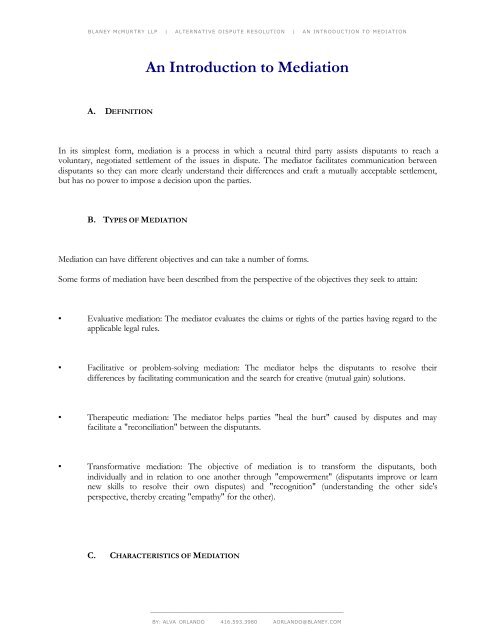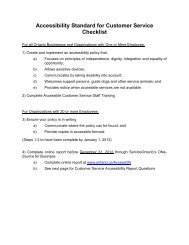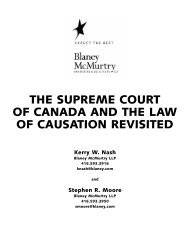An Introduction to Mediation (PDF) - Blaney McMurtry LLP
An Introduction to Mediation (PDF) - Blaney McMurtry LLP
An Introduction to Mediation (PDF) - Blaney McMurtry LLP
Create successful ePaper yourself
Turn your PDF publications into a flip-book with our unique Google optimized e-Paper software.
BLANEY McMURTRY <strong>LLP</strong> | ALTERNATIVE DISPUTE RESOLUTION | AN INTRODUCTION TO MEDIATION<strong>An</strong> <strong>Introduction</strong> <strong>to</strong> <strong>Mediation</strong>A. DEFINITIONIn its simplest form, mediation is a process in which a neutral third party assists disputants <strong>to</strong> reach avoluntary, negotiated settlement of the issues in dispute. The media<strong>to</strong>r facilitates communication betweendisputants so they can more clearly understand their differences and craft a mutually acceptable settlement,but has no power <strong>to</strong> impose a decision upon the parties.B. TYPES OF MEDIATION<strong>Mediation</strong> can have different objectives and can take a number of forms.Some forms of mediation have been described from the perspective of the objectives they seek <strong>to</strong> attain:• Evaluative mediation: The media<strong>to</strong>r evaluates the claims or rights of the parties having regard <strong>to</strong> theapplicable legal rules.• Facilitative or problem-solving mediation: The media<strong>to</strong>r helps the disputants <strong>to</strong> resolve theirdifferences by facilitating communication and the search for creative (mutual gain) solutions.• Therapeutic mediation: The media<strong>to</strong>r helps parties "heal the hurt" caused by disputes and mayfacilitate a "reconciliation" between the disputants.• Transformative mediation: The objective of mediation is <strong>to</strong> transform the disputants, bothindividually and in relation <strong>to</strong> one another through "empowerment" (disputants improve or learnnew skills <strong>to</strong> resolve their own disputes) and "recognition" (understanding the other side'sperspective, thereby creating "empathy" for the other).C. CHARACTERISTICS OF MEDIATION__________________________________________________________BY: ALVA ORLANDO 416.593.3980 AORLANDO@BLANEY.COM
BLANEY McMURTRY <strong>LLP</strong> | ALTERNATIVE DISPUTE RESOLUTION | AN INTRODUCTION TO MEDIATION• Voluntary - right <strong>to</strong> terminate• Private and confidential• Assisted or facilitated negotiation• Flexible (relatively unstructured)• Self-determining• Creative and practical• Future focussed• Without prejudice <strong>to</strong> participation in other processesD. ROLE OF THE MEDIATORAlthough media<strong>to</strong>rs may have different “styles” of mediating, their roles commonly include:1. Setting the <strong>to</strong>ne for joint problem-solving by establishing and maintaining a rational and productiveatmosphere for negotiation.2. Encouraging full disclosure of information.3. Assisting the parties <strong>to</strong> understand each other’s perspectives (needs, concerns, values, fears) andtrying <strong>to</strong> build empathy between the parties.__________________________________________________________BY: ALVA ORLANDO 416.593.3980 AORLANDO@BLANEY.COM
BLANEY McMURTRY <strong>LLP</strong> | ALTERNATIVE DISPUTE RESOLUTION | AN INTRODUCTION TO MEDIATION4. Facilitating communication between the parties by keeping the discussions “civil”; allowing parties<strong>to</strong> vent if appropriate; taking the “sting” out of loaded or angry statements by, for example, reframingthem in neutral way or in a way which reveals the underlying interest.5. Maintaining balance in the process by ensuring that the parties have an equal opportunity <strong>to</strong>speak.6. Identifying and seeking clarification of misunderstandings, assumptions, and discrepancies.7. Probing for interests underlying positions taken by the parties in order <strong>to</strong> expand the opportunity forcreative solutions.8. Assisting parties <strong>to</strong> identify common interests.9. Assisting the parties <strong>to</strong> explore and assess their alternatives <strong>to</strong> a negotiated resolution.10. Acting as a “reality check” by challenging parties on their positions (usually in caucus) and byreminding them of the costs of not settling.11. Assisting the parties <strong>to</strong> generate options for settlement and <strong>to</strong> develop criteria by which <strong>to</strong>evaluate those options.12. Assisting the parties <strong>to</strong> evaluate the advantages and disadvantages of each option and encouragingthe selection of an option which maximizes satisfaction of both of their interests.13. Keeping the parties focused on the future and their goal of resolving the dispute.14. Maintaining optimism that an agreement can be reached and sustaining commitment <strong>to</strong> assistparties achieve resolution.__________________________________________________________BY: ALVA ORLANDO 416.593.3980 AORLANDO@BLANEY.COM
















